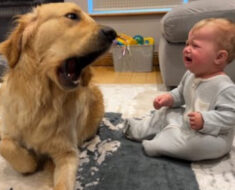Recent research suggests that dogs may express joy through tears, adding a new layer to their emotional communication. In a study conducted by researchers at Azabu University in Japan, it was observed that dogs produced more tears upon reuniting with their owners compared to when the owners stayed at home. This potential connection between tears and positive emotions in dogs is a groundbreaking revelation in understanding canine behavior.

The study, published in Current Biology, involved placing a strip of paper inside each dog’s lower eyelid to measure tear production. Tear production increased by 10 percent when dogs were reunited with their owners after a period of separation. The researchers also noted that reunions with owners resulted in more tear production than reunions with familiar non-owners.
To explore a potential hormonal link, the researchers tested the impact of oxytocin, a hormone associated with emotional bonding in humans and dogs. The study found that dropping oxytocin in dogs’ eyes increased tear production, while a control solution did not.
While this research offers a novel perspective on canine emotions, some scientists express skepticism about the methodology and conclusions. The use of paper in the dogs’ eyelids has raised concerns, with suggestions that it might have affected the study’s outcomes. Some argue that the excited movement of dogs could have influenced tear production by causing the paper to rub against their eyes. Additionally, the application of oxytocin eyedrops might have induced tears due to eye irritation.
Despite the skepticism, the study adds to existing knowledge about the emotional intelligence of dogs, showcasing their ability to express and experience emotions in ways that continue to surprise and deepen our understanding of the human-canine bond.
While the scientific community debates the connection between dogs’ tears and emotion, there is consensus that these tears can influence the relationship between dogs and their owners. In a separate experiment, 74 human participants were asked to rate photos of dogs based on their desire to care for the animals. The results revealed that people expressed a greater interest in caring for dogs displaying tearful eyes.
This suggests that certain visual cues, such as glossy eyes or the presence of tears, may evoke nurturing tendencies in humans. The emotional response triggered by these visual signals further underscores the intricate and mutually influential nature of the bond between dogs and their human companions.





